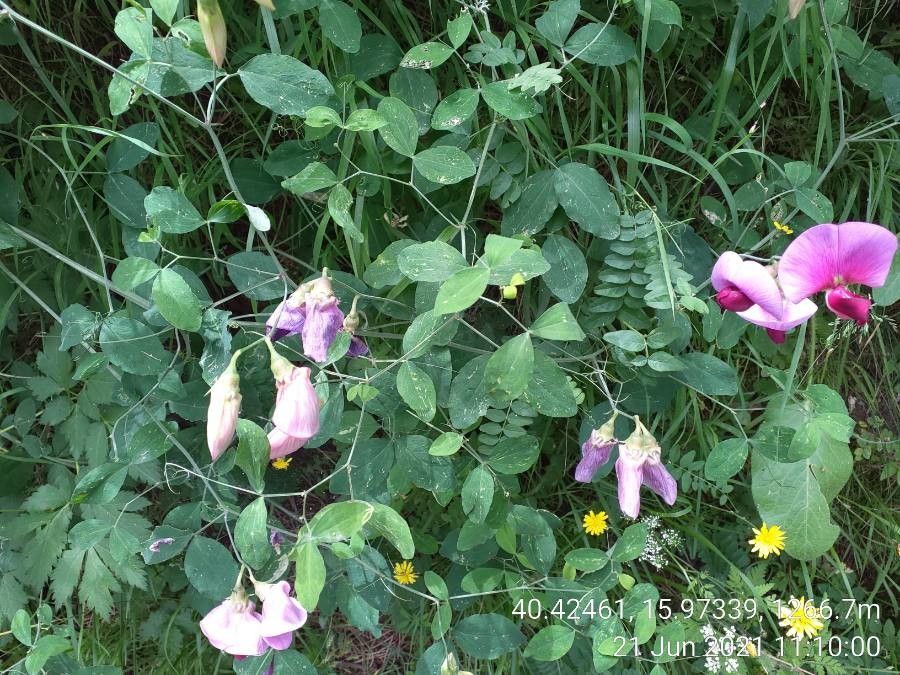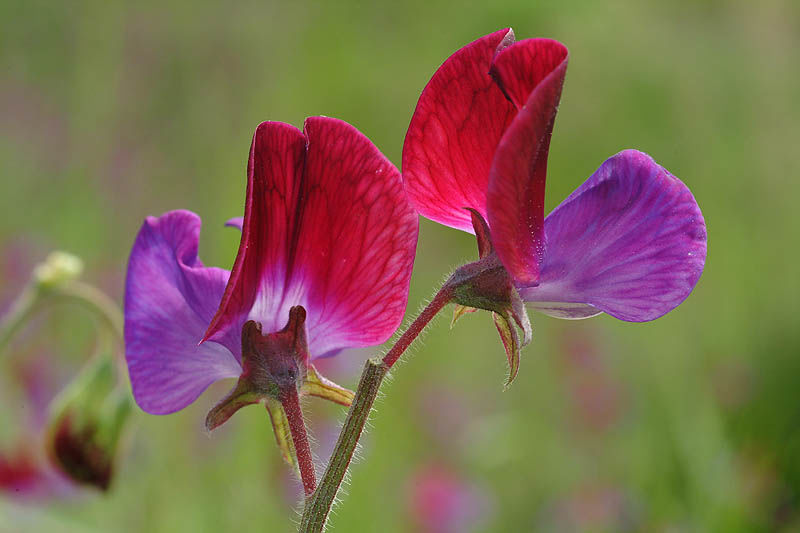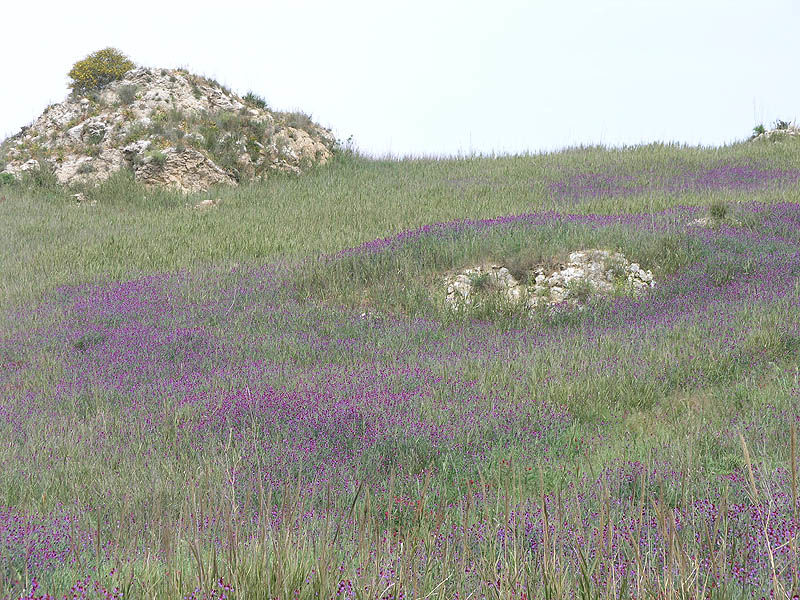Sweet Pea
lathyrus odoratus
Also known as: ["Garden Sweet Pea","Annual Sweet Pea"]
Overview
A fragrant annual vine in the legume family, known for its colorful, pea-like flowers and climbing habit.
Benefits & Perks
["fragrant flowers","wildlife attractant (bees, butterflies, birds)","low maintenance"]
Botanical Classification
| Phylum: | Magnoliophyta |
| Class: | Magnoliopsida |
| Order: | Fabales |
| Family: | Fabaceae |
| Genus: | Lathyrus |
| Botanical Name: | Lathyrus odoratus |
Plant Characteristics
Basic Information
- Category: Flowers
- Suitable Location: trellis or fence in garden, or container with support
- Suitable For:
- Is Weed: No
- Allergenicity: low
Environmental Needs
- Climate: {"temperatureRange":"10–30°C"}
- Hardiness: {"zones":"8–11"}
- Misting: rarely required, only if ambient humidity is very low
- Drainage: Fast-draining to prevent waterlogging.
- Soil Type: Well-draining, loamy soil with added organic matter.
Maintenance Level
- Maintenance Level: moderate
- Toughness Level: moderate
- Pruning Frequency: As needed; after flowering or in early spring.
- Pruning Intensity: Light to moderate; avoid heavy pruning unless necessary.
Care Details
Ideal Sunlight Coverage:
Full sun (6–8 hours/day); tolerate partial shade in hot climates.
Sunlight Tolerance Tips:
Acclimate gradually to intense sun; protect from harsh afternoon sun to prevent scorching.
Care Requirements
Care Difficulty
moderateeasy
Sunlight
full sun to partial shade
Morning sun is ideal; rotate plants for even growth; avoid direct midday sun in summer.
Watering
every 5–7 days during active growth, reduce in winter
Water at the base to avoid foliage disease; ensure soil dries slightly between waterings.
Soil
well-draining, fertile, loamy soil
pH: 6.0–7.0 (slightly acidic to neutral).
Ensure good drainage; avoid heavy clay; enrich with compost.
Temperature
60–75°F (15–24°C); tolerate cooler nights but avoid frost.
Avoid sudden temperature shifts; protect from frost; ensure good air flow.
Fertilizing
every 2 weeks during active growth, monthly in spring and summer
Dilute to half strength; avoid over-fertilizing; stop before flowering.
Propagation
Methods
Seed sowing; stem cuttings (less common).
Step-by-Step Propagation Guide
- Sow seeds 1 inch deep.
- Keep moist.
- Thin seedlings.
- Or take cuttings, apply hormone, and place in medium.
Best Time: Spring or early summer for seeds; late spring for cuttings.
Environment
Warm (65–75°F), high humidity, and bright indirect light.
Medium
Well-draining seed starting mix or perlite/vermiculite mix.
Hormone
Not typically needed for seeds; optional for cuttings.
Timeline
Seeds germinate in 7–14 days; cuttings root in 3–4 weeks.
Tools Needed
Seed trays, pots, labels, watering can, optional rooting hormone.
Quick Tips
Soak seeds overnight for faster germination; use bottom heat for seeds.
Pruning & Repotting
Pruning Guide
Method
Pinch back tips to encourage bushiness; remove spent flowers.
Pruning Plan
Focus on removing dead or weak growth to encourage flowering.
Tools
Pruning shears, gloves, clean knife.
Checklist
Sterilize tools; prune dead growth; shape as desired; clean up debris.
Repotting Guide
Best Season
Early spring before active growth begins.
Pot Size
One size larger pot; ensure it has drainage holes.
Method
Use fresh well-draining soil; gently tease out roots; ensure good drainage.
Suggestions
Repot annually or when roots fill the pot; supports vigorous growth.
Checklist
Check root bound status; prepare new pot; use fresh soil; water after repotting.
Advanced Care Tips
Watering Mastery
Watering Checklist
Check soil moisture; water deeply; ensure drainage; adjust for season.
How to Apply Water Properly
Water thoroughly until it drains from the bottom, ensuring even moisture reaches the root zone without waterlogging.
Watering Schedule Tips
Water deeply once the top inch of soil feels dry; reduce frequency in winter to prevent root rot.
Soil Improvement
Add perlite or sand for drainage; incorporate compost for fertility.
Temperature Stress Management
Signs of Temperature Issues
Wilting, yellowing leaves, or stunted growth in extreme heat or cold.
Cold Stress
Slows growth, may cause leaf drop or damage if below 50°F (10°C).
Solution: Provide frost protection; move indoors in winter; avoid cold drafts.
Hot Stress
Leaves may wilt or scorch; flowering may decline in excessive heat.
Solution: Provide shade during peak sun; increase watering; improve air circulation.
Fertilizing Guide
Fertilizing Checklist
Check fertilizer type; dilute properly; apply during active growth.
Fertilizing Method
Balanced liquid fertilizer every 2–3 weeks during growing season; reduce in winter.
Common Problems & Solutions
Toxicity Warning
Cats
Slightly ToxicCats are also susceptible to lathyrism if they consume large quantities of Lathyrus odoratus seeds or beans. The condition can cause progressive paralysis and muscle weakness, similar to that in humans and dogs.
⚠️ Symptoms:
🌿 Toxic Parts:
⚡ Toxic If:
if eaten in large quantities
Dogs
Slightly ToxicIn dogs, ingestion of large amounts of Lathyrus odoratus seeds or beans can lead to lathyrism, characterized by progressive paralysis and muscle weakness. The condition is rare but serious if untreated.
⚠️ Symptoms:
🌿 Toxic Parts:
⚡ Toxic If:
if eaten in large quantities
Humans
Slightly ToxicLathyrus odoratus contains amino acids that can cause lathyrism, a neuromuscular disorder, when consumed in large amounts over time. The toxic effects are primarily neurological and can lead to paralysis if not addressed.
⚠️ Symptoms:
🌿 Toxic Parts:
⚡ Toxic If:
if eaten in large quantities
Frequently Asked Questions
Q: How do I grow Sweet Peas from seed?
A: Sow seeds directly into well-drained soil after the last frost, providing support for climbing. Seeds can be soaked overnight to speed germination.
Q: Why are my Sweet Pea flowers not fragrant?
A: Ensure the variety is known for fragrance, and plant in full sun for optimal scent production.
Q: Are Sweet Peas edible?
A: While the flowers are sometimes used in culinary decorations, the seeds and pods of Lathyrus odoratus are mildly toxic if ingested and should not be consumed.
Quick Reference
| Family: | Fabaceae |
| Care: | moderate |
| Light: | full sun to partial shade |
| Water: | every 5–7 days during active |
Get Expert Care Tips
Download the Plantious app for personalized care reminders and plant identification!
Google Play App Store








